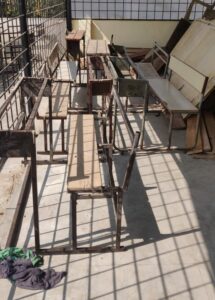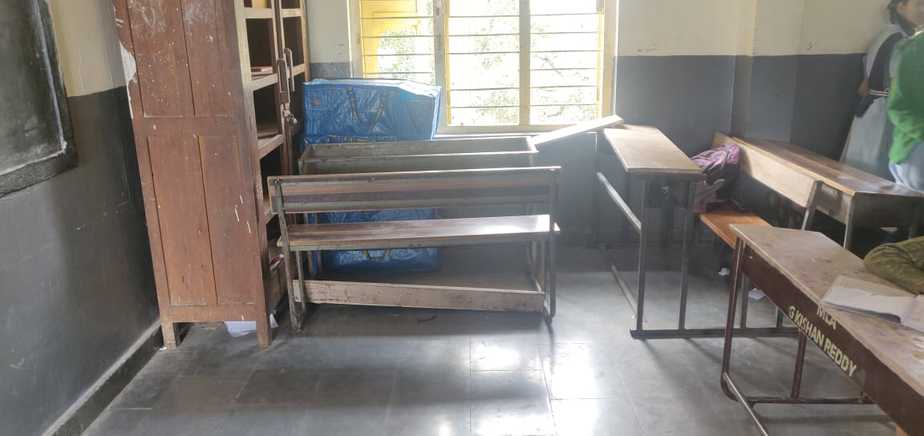Written & Photographed by Apurva Sankar
Working as a Teach For India Fellow in a government school for the past 2 years has given me lots of exposure to the challenges faced by schools. However, one challenge that stands out, is the need for good school infrastructure. School infrastructure should include services that make the learning process seamless. This includes physical infrastructure like benches, books, doors, buildings, and playgrounds, and intellectual infrastructure like libraries and well-trained, qualified teachers. Then, there’s also social infrastructure like platforms that foster better interaction among students and teachers. The absence of functioning infrastructure and utilities leads to a significant loss of instructional time, ultimately affecting educational outcomes.
However, in spite of the common knowledge that school infrastructure plays a crucial role in the performance of a student, its marked absence in schools, especially government schools, calls for a deeper analysis of the problem.
What does the research say?
There is a plethora of research that confirms that school infrastructure plays a major role in the education and development of a student. Quantitative research discusses the impact of lighting, class size, buildings, and many other facilities on students and their academic performances. One article in particular speaks about how a positive school climate with well developed social infrastructure can improve students’ educational experiences both scholastically and otherwise too. Research also notes how placing plants in a classroom, having brightly coloured walls, good air quality, and controlled classroom temperatures can positively affect the learning capabilities of students.
“A positive school climate provides an environment where students feel valuable; at the same time, it widens the potential of students to increase their academic achievements.” [1]
These subtle yet crucial details can significantly impact students, and potentially increase the disparity between students who have access to such facilities and students who don’t. However, such aspects are rarely considered when classrooms are designed in India.
What is the reality?
The District Information System for Education (DISE) statistics on the availability of school infrastructure for the academic years 2013-14, 2014-15, and 2015-16 are telling. The figures measure five main facilities, namely boys’ toilets, girls’ toilets, availability of computers, drinking water supply, and electricity, and presents a mixed view of the reality of school infrastructure.
On the one hand, it is heartening to note that necessities like toilets and drinking water are available in almost 95% of Indian schools. There has been a particularly steep hike in the availability of boys toilets from 88% in 2014-15 to 97% in 2015-16. This may be due to the Swachh Vidhyalaya Initiative, part of the Swachh Bharat Abhiyaan, undertaken by the government in 2014 to build 4 lakh toilets in 2 lakh schools within a year. However, the same statistics also note that in this era of digitisation where nothing works without basic electricity, only 60% of schools have access to electricity, and only 27% have access to computers! This raises the crucial question as to how we are equipping our students to cope with the digital revolution.
Besides these data sets, data about many other important factors like lighting, seating conditions, and classroom colours are not even measured. Therefore, there is a clear gap between policy-level understandings of what a ‘well’ developed school is, what scientific research says, and the reality of our schools. How does this mismatch arise?
What do the stakeholders have to say?

Teachers readily open up about their needs in the school. “We definitely need good benches, cupboards, blackboards, and books. But, we rarely have these things and even if the government provides 200 benches, 100 of them break within a year due to poor quality.” The puzzle of electricity availability in schools too is answered by the teachers. “It is the government’s duty to provide free electricity. But the issue arises when instead of the bills being paid Centrally, the school staff needs to instead pay the bills and then seek reimbursement! Due to lack of [immediate] funds, the bills are unpaid leading to severance in the connection.”
One of the teachers in our school, Ms. Radhika fondly remembers her days at Aurobindo School, a private school in Hyderabad, for its infrastructure that was conducive to better teaching.
“We had a teachers’ library with books on pedagogy and student psychology, encyclopedias, and other reference books to help teachers increase the rigour of their lessons. We also had 6 hours to sit and prepare for our classes so that we could deliver the best for the students. Sessions were held every Saturday where we discussed the daily issues of the class and motivated each other.”
Such social infrastructure helps create a support system for teachers where they can share resources, and be of help to each other. This kind of social atmosphere is seldom found in government schools because most schools don’t have a staff room where teachers can socialise, or, they are understaffed to the extent that most teachers don’t have the free time to socialise at all.
Students are equally clear on what kind of infrastructure any school needs. They understand the impact that benches, boards, books, and electricity have on their own performance. But one major issue is their lack of knowledge on the bodies that provide them these facilities.
This is another challenge. If the students and teachers themselves don’t know what facilities are guaranteed to them under the Right to Education Act, they would take little action on their part to make sure they receive the facilities they are entitled to.
Then, what can be done?
The government’s education budget accounts for only 3-4% of India’s total GDP. Tongues are wagging in the MHRD Ministry that current budgetary allocations for schools could be cut by up to 3000 crores, due to “fund constraints.” One of the main reasons for such low, or even reduced, investment in the education sector, especially in infrastructure, is that the return on investment in terms of human resources is only seen in the long-term. Furthermore, the impact of infrastructure is not directly measurable.
That’s not to say that the government has done nothing. The Swacch Vidhyalaya Initiative, Midday Meal Scheme, Balika Manch, and Beti Bachao-Beti Padhao Yojana are some of the many schemes that the government has come up with to create an environment that fosters better learning. The issue is that structural challenges arise in the implementation of government programs. Many of the times, the trickle-down effects of the program to grassroots levels are non-existent or inefficient, rendering most policies useless.
You May Also Like: Educating India’s Daughter: Has the Beti Bachao Beti Padhao Yojana Worked?
However, once students and teachers know what their rights and privileges are, chances are they’ll be more proactive in making sure they receive them appropriately. One such example is a 2018 PIL filed by a Mohammad Mumtaz Ansari of Wasseypur, Jharkhand, demanding basic infrastructure for a local Urdu-medium school. According to the PIL, Ansari asserted that in the absence of basic facilities like benches, desks, and teachers, 498 students enrolled in Grades 1-8 were crammed into two classrooms over the school year. Unsurprisingly, the school did not have an electricity connection either. After hearing the petition, the Jharkhand High Court directed the state government to take appropriate action, and ensure that all facilities were provided to the school in a time-bound manner.
This kind of action maintains a citizen-led system of checks and balances, so that the responsibility of maintaining infrastructure isn’t left solely in the hands of the government. And so, infrastructure development in schools should be imagined as a collaborative exercise between the state and the citizen, and be prioritised as such. No matter how many crores are spent on education curriculum or delivery, until and unless the basic infrastructural needs of a classroom are satisfied, quality education for all students will remain a distant dream.
[1] Dulay, Sabiha, Karadağ, and Engin. (2017). The Effect of School Climate on Student Achievement. DOI: 10.1007/978-3-319-56083-0_12









[…] You may also like: A Low Benchmark: The State of Infrastructure in Our Schools […]
[…] unusable toilets, playgrounds filled with garbage, and overfilled classrooms. This has a direct impact on student motivation and engagement, as the “Quality of learning spaces is intricately linked to the self-respect that students feel […]
[…] not to say that quality infrastructure doesn’t impact educational outcomes: The Bastion has previously reported on how better developed schools can directly improve the willingness of students to attend them. […]
When I say infrastructure, I have already mentioned that I’m talking about 3 types of infrastructure- physical, intellectual and social. In the school that I’m working as a Fellow there is a dire shortage of all these types of infrastructure. In case you are looking for more specific details about the lack of infrastructure do feel free to write to me personally.
Hello, we are working on education, we are working on enhancing the learning level of students(At research level)
Surely infrastructure is a core component we need to solve. can you elaborate more about the existing problems, because they are interconnected?
Our motto is finding Root causes of the issues.
As I have already mentioned in the article, a whopping majority of government schools in India don’t have the 3 main facilities of toilets, electricity and computers. In the school I teach, students don’t even have adequate benches to sit and hence sit down most of the time. In case you are looking for more specifics, you can write to me personally.
I had already written to you. please check.
I had already written to you. please check.